Howie Tsui (Tsui Ho Yan / 徐浩恩) is a Vancouver-based artist who was born in Hong Kong and raised in Lagos, Nigeria and Thunder Bay. Retainers of Anarchy is a twenty five meter long long five channel animated scroll with six channel audio.
According to Tsui, Retainers of Anarchy is considers wuxia as a narrative tool for dissidence and resistance. Wuxia, a traditional form of martial arts literature that expanded into 20th century popular film and television, was created out of narratives and characters often from lower social classes that uphold chivalric ideals against oppressive forces during unstable times. The people’s republic of china placed wuxia under heavy censorship for fear of arousing anti-government sentiment. However practitioners advanced the form in Hong Kong making it one of the most popular genres of Chinese fiction. Retainers of Anarchy, is an installation with hand-drawn animation that references life during the song dynasty (960–1279 CE), but undermines its idealized portraiture of social cohesion by setting the narrative in Kowloon’s notorious walled city—an ungoverned tenement of disenfranchised refugees in Hong Kong which was demolished in 1994.
Howie Tsui, Retainers of Anarchy, algorithmic animation sequence, 5-channel projection, 6-channel audio, Vancouver Art Gallery, 2017
LZ: Your installation Retainers of Anarchy is very unique in that it involves hand-drawn animation on such a large scale. Could you speak about some of the processes involved in making it?
HT: The whole production of Retainers of Anarchy (ROA) is a little bit unorthodox in terms of installation pieces because of the technology and all the different processes involved. I’ve always wanted a certain kind of mark-making and intimacy to be present in my work. The challenge is to do that with a work of that scale which has to go through multiple machine processes. The issue becomes how you maintain the humanity there, right? I think that is what makes ROA a really labor intensive process. In any normal contemporary work that is formally similar they’d be using software like unity, vector-based images, and an algorithm that makes things move the way you want to. But with ROA we were working in a way where everything was very manual as well as being digital. It goes from my original drawings; to the animators who fill in the in-between frames; some digital drawing; then on to my programmer and collaborator Remy Siu. He manually typed in a lot of individual codes in order to bring the drawings to life. Remy is a really talented media artist and composer. I collaborated with him on a project with his collective, Hong Kong Exile at Centre A. I started approaching him about Retainers of Anarchy and sent him videos of Rivers of Wisdom, an animated scroll of the Song Dynasty painting Along the River During the Qingming Festival. I asked him if there was a way we could do something like it?
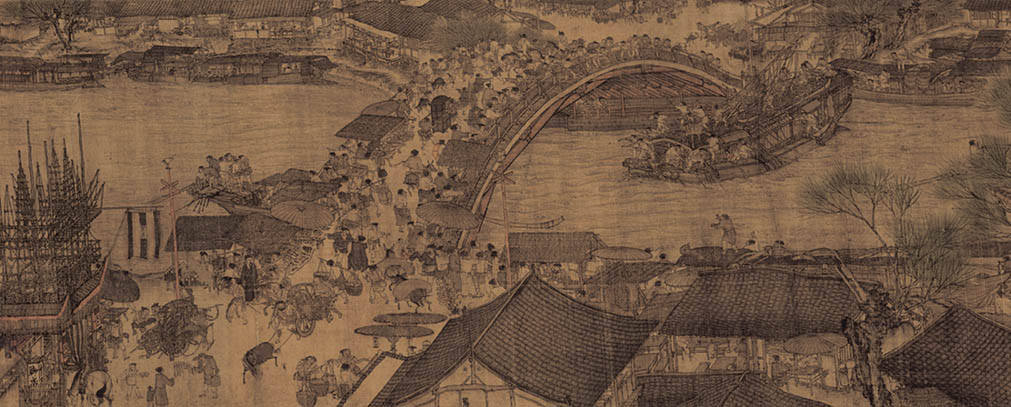
Along the River During the Qingming Festival (清明上河圖), the 12th-century original by Zhang Zeduan
LZ: Can you talk a bit about your experience collaborating with animators? How much freedom or agency did you give them to fill in the in-betweens and dictate the timing of the action?
HT: When the project started I didn’t really know how I would animate it. I met with a professor at Emily Carr University of Art and Design, Martin Rose –who was a bit of a consultant and streamlined how to work with the animation. He also recommended students for me to work with and I established this kind of Co-op program. I worked with Roxanne Zagar, Kodai Yanagawa, Amelia Earhart, Kerel Alaas, and Sitji Chou to produce the animation. But in terms of in-betweens, yeah… I gave them a lot of agency. I’d only get involved if things totally irked me –then I would make suggestions for how the movement could be tweaked. Generally, I gave them the keyframes with some source images and reference videos. But for me, just to see my drawings actually move is kind of like gravy.
In ROA there’s such a large volume of animations. I also knew I wanted them to be very short like GIFs. For me, that’s related to the idea of memory and all the films and TV shows that I watched as a kid. A lot of things were just snippets and scenes that I’d remembered or a particular trope in martial arts fantasy fiction. So you know, I trust them a lot. I mostly gave some direction, but the animations in ROA were pretty short. It’s pretty easy to hone-in with care and create a lot of detail, but not for too long. I trust what they do because I don’t have the same expertise. So unless something’s really off I let them be.
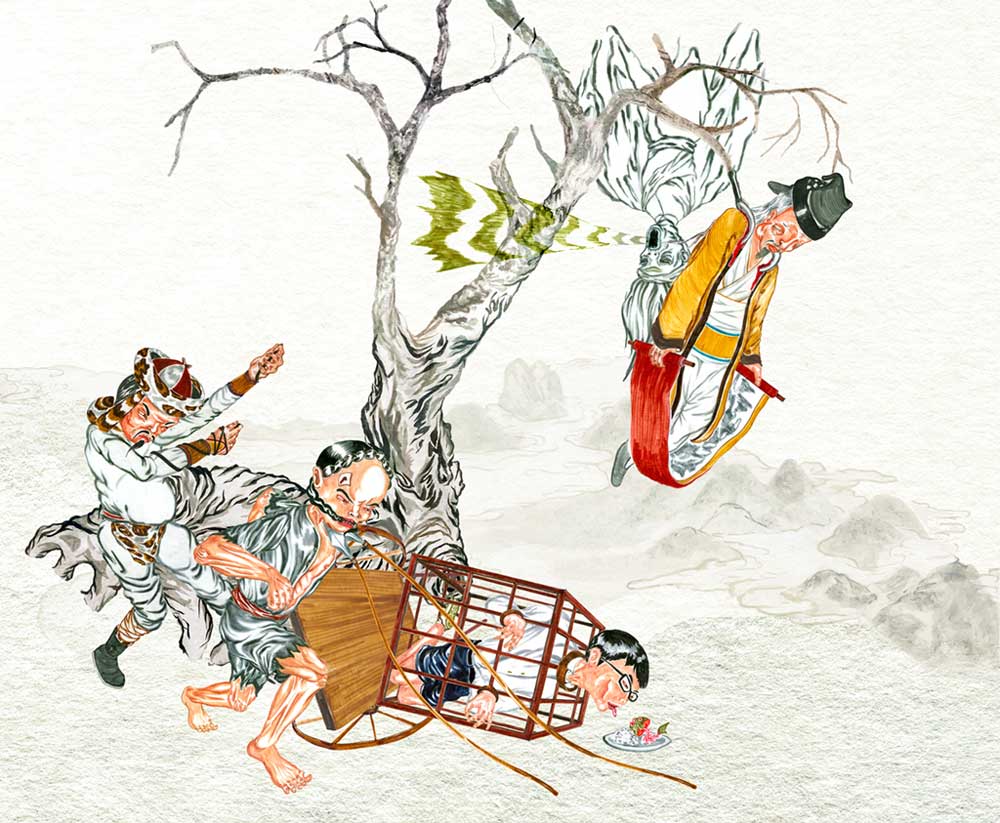 Howie Tsui, Retainers of Anarchy, 2017
Howie Tsui, Retainers of Anarchy, 2017
I think a challenge though, is my inking style. At least for the work in ROA, which is a little different than my normal inking style on rice paper. There are a lot of gradients, it’s very organic. So in terms of having to digitally colour frame-by-frame – that is the laborious part. The animators I worked with are keen to do the animation. They’re really good at getting the timing and the motion but then the colouring is a whole other component.
LZ: How did create the different characters in ROA? Did you find contemporary figures you wanted to represent? What were some of your approaches to world building?
HT: You know, there’s so much, it’s so rich, these stories. At that time I was re-watching a lot of martial arts films, but I was just absorbing everything. So I had noted in my head when a certain scene was of a caliber that I would want to capture. There’s still so many more. But when I found a scene that was rich, I would ask myself, what is a contemporary or modern day kind of avatar for this scene? How can it be parallel to a contemporary context or something that is currently happening? Which is kind of the way I was constructing pictures prior to anything being animated. I was building these maximalist picture spaces. I would ask, what is the potentiality of this particular image to bounce off of this other image over here and then develop its own hypernarrative structure? I considered that when I was choosing the figures – but figure design is all very intuitive. That’s kind of freestyle sketchbook stuff.
LZ: Can you talk a little bit about your relationship to animation? Is it something that you’ve always admired or were interested in?
HT: A lot of my decisions in studying art probably had to do with my interest in animation, even just in its pop art forms. When I was growing up – whether cartoons, manga or anime – I kept on continuously following it. In art school I wasn’t exposed to animation too much because that was before the Internet. You could only see so much stuff. So I’d go to the artsy video store and rent Secret Adventures of Tom Thumb or a bunch Jan Švankmajer films. In a way I have this love for animation, but it never intersected with art in the way it was taught in the institution. The only thing you get is William Kentridge, and it was only at the tail end of my time at art school when Takashi Murakami’s Superflat showed up. But that was cool because I knew it was artwork about animation culture and animation geeks otaku. It was really refreshing for me, because at that point I had a very narrow view of what the art world was and what it would accept as art. I really liked animation for many reasons, but particularly since I was born in Hong Kong, and animation has this universality because there is no language, right?
LZ: Yeah, it can cross borders very easily.
HT: That’s why I also tend to produce art that’s image-based and avoid a lot of text, because I find that is limiting. It’s not as universal. There’s a power dynamic between English and other languages. If people don’t know the language they can’t access the work. You may not know English if you’re not of a certain class, or from a certain country right? That’s why I’ve always preferred animation because it could speak to more people and be direct.
LZ: The Rivers of Wisdom is a massive installation and an inspiration for Retainers of Anarchy. Without seeing it in person it’s hard to fully grasp it in its entirety because it’s so massive. But the animated movement of all the figures walking were very programmed and stiff. They didn’t have any character. There is a juxtaposition between their stilted movements and the drawing style of the 12th-century artist Zhang Zeduanand that the figures were put into. It’s very disconcerting. I was wondering if you noticed that, and if that impacted how you approached animating your characters in ROA?
HT: Yeah, the landscape environment was very flattened and the figures sat on top of it. There was this CGI smoothness applied to their movement. There’s no gravity or weight, they don’t seem to hit the ground when they walk. They’re floating.
So yeah, Rivers of Wisdom was the basis of ROA, but I wanted to make a more human and grittier version of it. Or taking the idea of Rivers of Wisdom – because it was this spectacle, and it’s a Chinese art tradition of doing renditions of a certain landscape over and over. But by different artists, like cover songs. Each new artist puts stamps on their rendition. ROA is playing with that tradition. But with Rivers of Wisdom; bastardizing it all or just using that concept to make it my own and communicate my own message.
LZ: The choice to do it all using hand-drawn traditional animation and keep that hand-made quality is really apparent. The movements in ROA are grounded, they have weight, they move like real figures that are a part of their world. If you were creating all the scenes and animation as short animated GIFs, how did the software interpret the animation so that it wasn’t so robotic and stilted?
HT: All the animations were created separately and were considered ‘assets’. We used touchdesigner to basically manage these assets. The program places the assets in this space, and then the algorithm controls the camera moves in order to frame the picture. For example, zoom out is one camera, another camera pans across slightly – there were like 40 cameras. Once you start developing all these different cameras – which are assigned to all the various animations – you are programing the movement of the cameras. When you hit play, the algorithm we created dictates how the computer jumps from camera to camera. That’s how the work lived in the gallery. In this random jumping from scene to scene, zooming in and out.
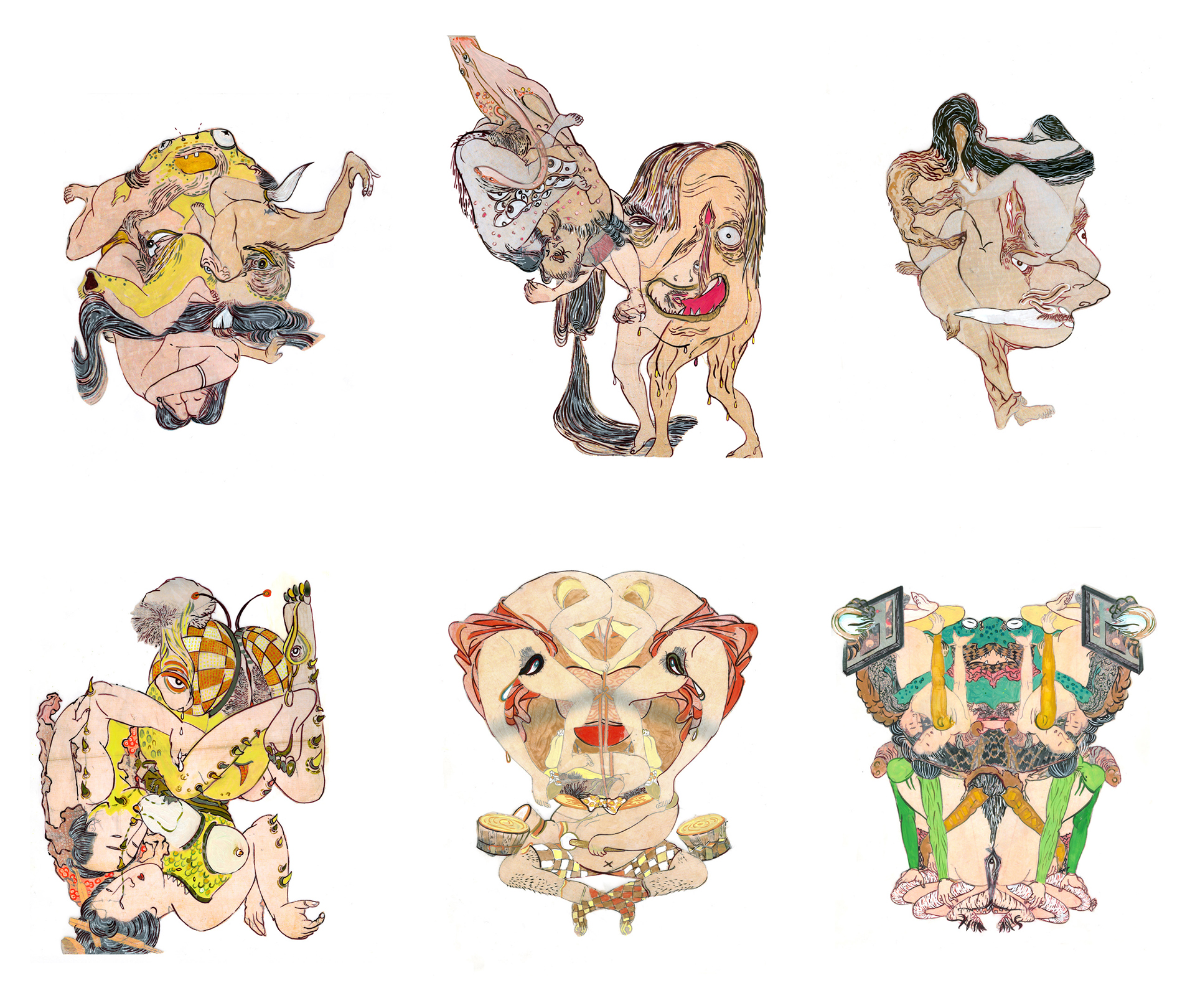 Howie Tsui, Of Shunga & Monsters, acrylic, ink and collage on polyethylene drafting film, 2007 – 2008
Howie Tsui, Of Shunga & Monsters, acrylic, ink and collage on polyethylene drafting film, 2007 – 2008
LZ: How do you feel about using technology that gives up so much of your control versus the very tactile and material quality of your drawing practice that has so much of you embedded in the drawings and the characters that you make?
HT: I quite like it. It’s unexpected. Part of a problem I have with my drawing – and my normal way of making artwork – s that over the years you practice and you want to be technically masterful at drawing and various mediums, but that gets tired after a period. Even before – in the mid-aughts – I had a period where I was getting burnt out from the images I was creating because they were too predictable. I had too much control over what they would look like. So I started doing these collage drawings as an exercise. They’re collages that used Shunga – Japanese spring erotica –but I fragmented them and created subconscious portraitures out of them. In that way they became more of a looking exercise. It was taking something pre-existing and letting it go.
I think there’s a lot to the algorithm, the computer, and letting that dictate the narrative and how the work moves. You know, in a lot of ways, this is part of Remy’s artistic practice, which is letting algorithms produce work up to a point and seeing if the computer will learn something, and then how will the work change from that. Earlier on when we started running ROA on monitors, we would sit and wait and wonder where’s it going to go. It seemed like there was a strange logic that the computer was starting to form because – let’s say the camera is following a horse moving left and then it goes to another camera that is on the left side – it almost seemed like the computer was trying to make these transitions smoother – less jarring moving from left to right. But that could have been just us thinking that, and not what the computer was actually doing.
Originally when I was thinking of the project, I just thought it’d be an animation. And just like the River of Wisdom have a clear start and end – essentially a video. It wasn’t until I knew what the software was capable of doing that I was like, this is way more exciting. Of course it leads to more challenges in terms of exhibiting it.ow can it be preserved as a work if it were to be acquired at a museum as a live rendering? But this algorithm is important to the theme of the work, which looks into anarchic societies versus this idea of self organized societies and how that is juxtaposed with the imagery of chaos. But inside there’s actually this border – just like the Kowloon Walled City was seemingly an anarchic society – but it also has its own operating code of how it functioned. So the algorithmic component mirrors the thematic in terms of systems.
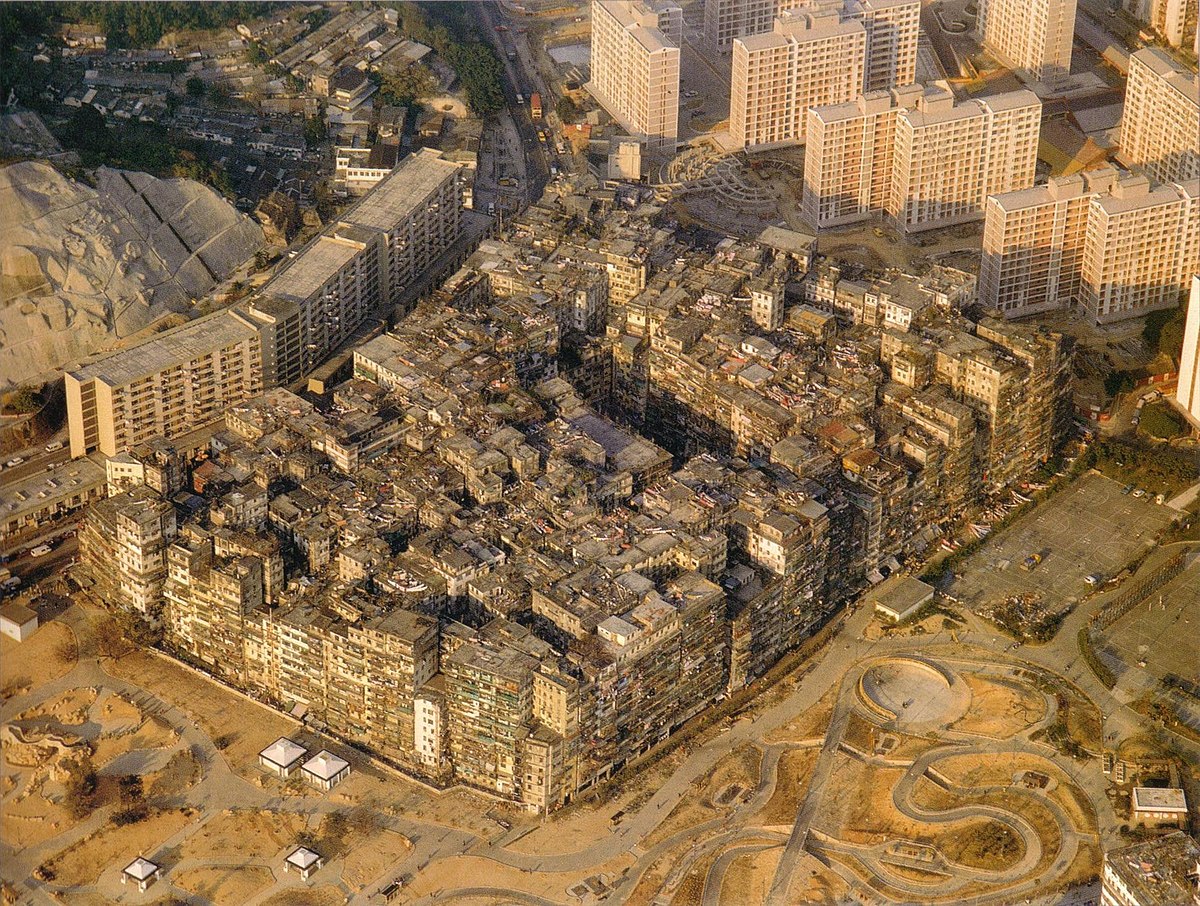 Aerial view of the Kowloon Walled City in 1989
Aerial view of the Kowloon Walled City in 1989
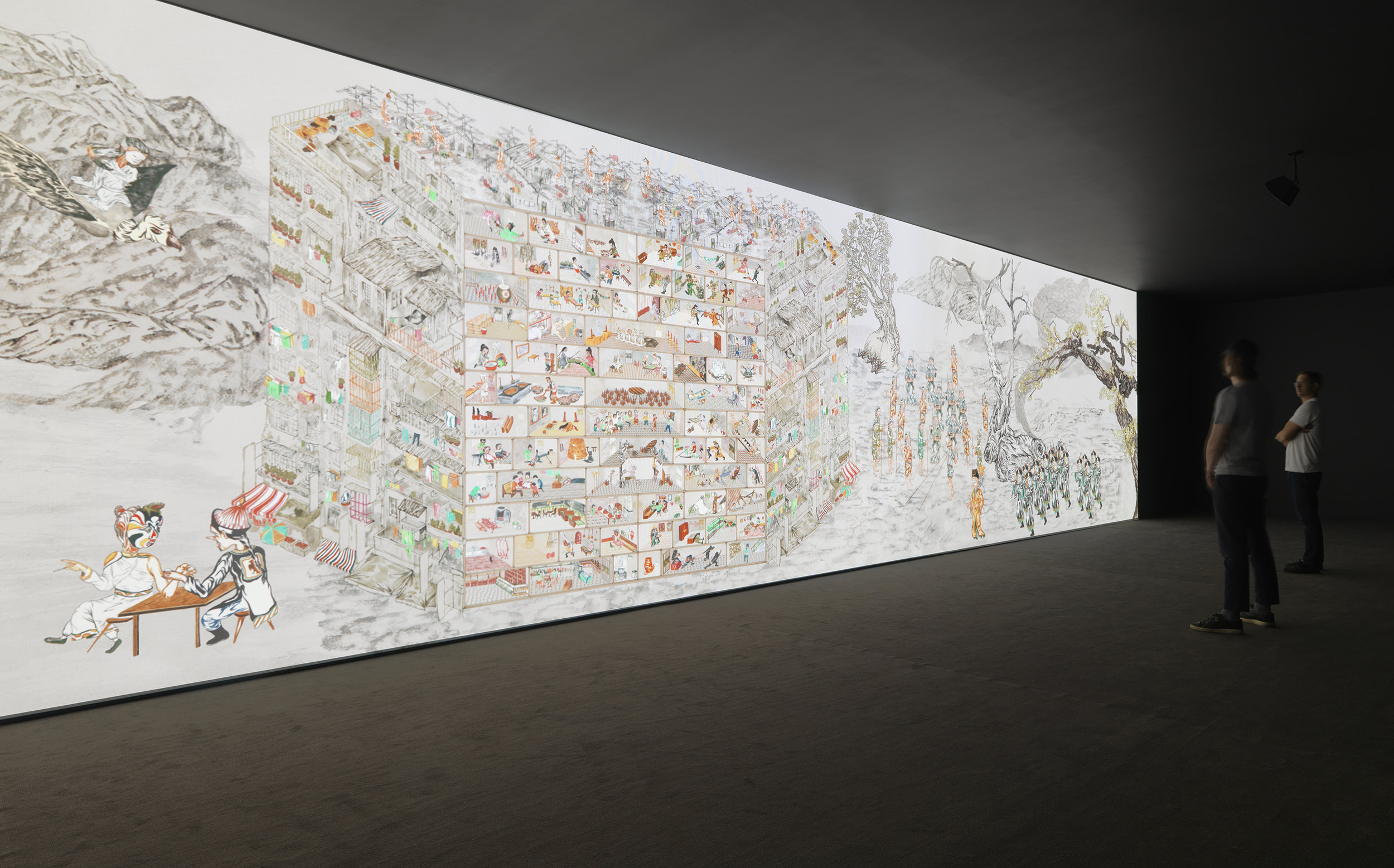 Howie Tsui, Retainers of Anarchy, Installation, Vancouver Art Gallery, 2017
Howie Tsui, Retainers of Anarchy, Installation, Vancouver Art Gallery, 2017
LZ: In ROA It’s difficult to see the piece cumulatively because of its size. Not only is there the camera dictating what you see but there’s also the physical aspect of yourself in the room panning left or right, zooming-in closer to see all the different parts of the action.
Retainers Of Anarchy is different from Rivers of Wisdom, in that the the hand-drawn nature of all the different elements from the characters to the foreground and background textures that move – it takes the flatness out of it. The irony is that you are working in 2D which is by nature flatter than if you’re working in 3D but you’ve created a drawn space that the computer adds depth to.
HT: I tend to work in 2D but the program we used in ROA is 3D. We were placing things in some imagined 3D space even though, you know, everything – all the objects – are flat. That’s how you get the nice parallax effects. But that’s a good point that it’s 2D. It’s more realistic than 3D. Aesthetically I find 3D rendered things to look like tubes and they are less organic.
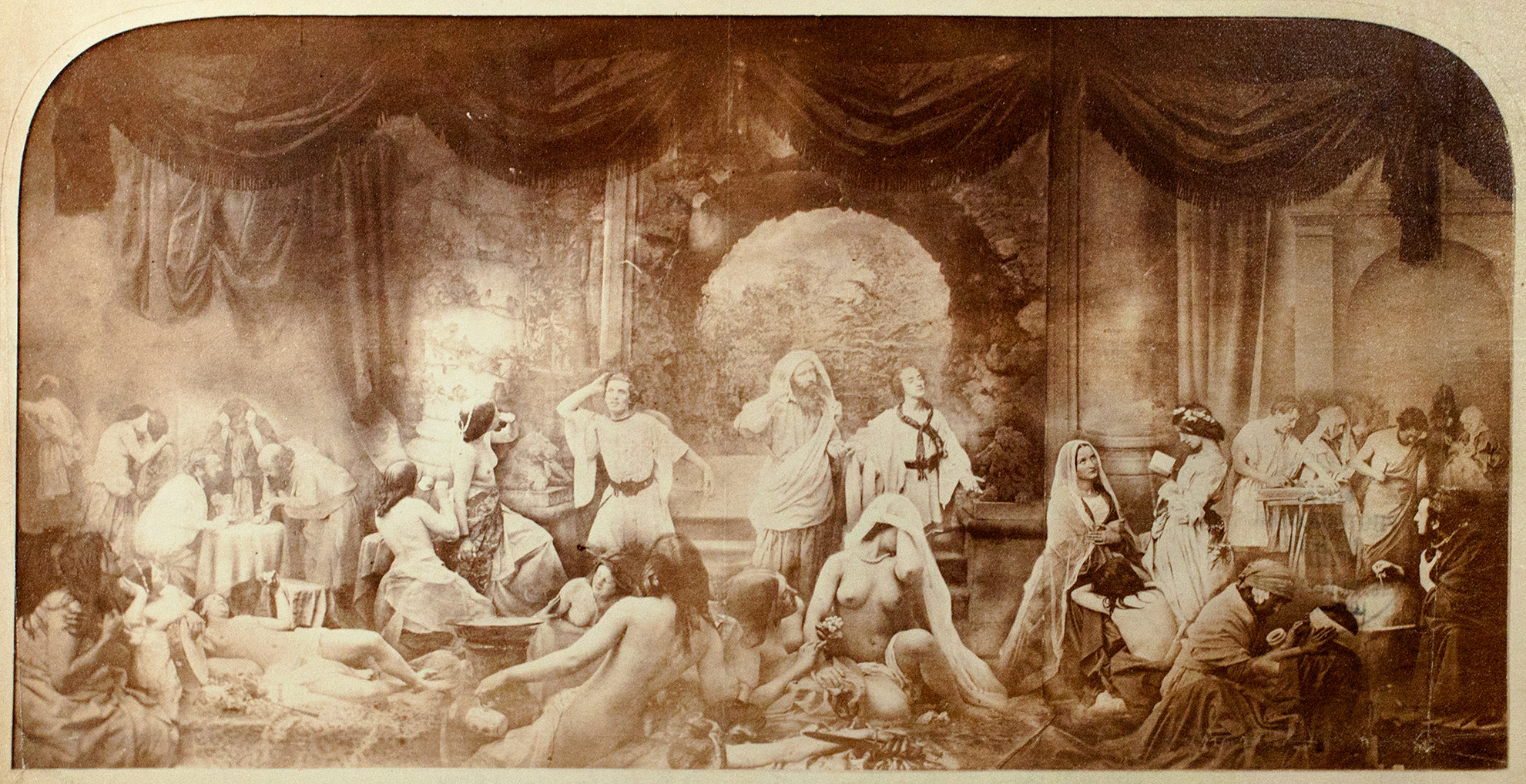 Oscar Gustave Rejlander, Two Ways of Life, photo montage, 1857
Oscar Gustave Rejlander, Two Ways of Life, photo montage, 1857
LZ: I went to a talk by Kaja Silverman who spoke about a photograph by Oscar Gustave Rejlander called the Two Ways of Life from 1857. It’s made up of 32 different images composited into this one scene. In the center two figures are presented with allegories for either virtuous or sinful ways of living on either side. In the photograph the perspective is skewed. All the different characters were photographed in different places and then composited together. The photograph is a really early example of trying to composite different people and spaces together into one singular space. The work is unique in that it’s not only compositing figures in varying perspectives and camera angles but also into allegorical ones. I think it’s interesting to think about this image in relation to this whole idea of a composite and the differences between a work like Retainers of Anarchy and Rivers of Wisdom. In both cases there is the added element of time because these images are moving, but there is also a powerful software that dictates how all the different assets, figures or layers move through an artificial backdrop.
In ROA I was stuck by how particular background elements, like the water, seemed to move 3 dimensionally, making it pixelated. Or the resolution around the edges of a particular asset that would all of a sudden become more apparent depending on how a camera framed the action. This is inevitable when you are working with something so flat and with so much texture that is created in one dimension, but you force it into another. How did you approach resolution and the technical issues that arise from compositing all the different parts together to create the animated scroll.
HT: At first I was like, this is how I envisioned it so I made all the components that way. But you know, Remy from the get go was like, “we’re going to need a really crazy computer to process this because these are straight up bitmap images. We’re not vectoring anything.” If I did, then it would have lost all its quality. I think it was very unnerving to be spending all this time building up assets without a clear answer if the computer could handle it, or what was going to happen. It was only closer to the tail end that we started to assemble a composite of the whole thing. Then you’re like… oh computer crash. Or, it’s really great at managing assets of really high resolution JPEGs, but it doesn’t like video. I had a landscape originally at a higher resolution but had to lower it in order to suit the computer. In terms of the life of the work there’s also the issue of what happens in the future. Can it be super high-resolution once a computer can handle that?
By the end we were mostly fighting with frame rates because of the bitmap. But you know, at first the bittiness was bugging me. I wished the file could have been at a higher resolution so when we zoomed-in it didn’t look as bitty. But then I think the work expanded my relationship with the digital medium. I had to live with something bitty, because in the this work, it does get into these granular low resolution moments. For me, it’s like, great. Now, this is kind of abstracted and then it’s all very formal. This is the material and these are the numbers right? So I think the algorithm, and forcing bitmap into the work, opened me up to that kind of quality. Or, that aspect of digital media that, I think, before I either ignored or didn’t want to look at in that way. I don’t think previously I was ever working in digital media or working in a way that was very, kind of super, you know, chunky. Previously everything was more refined. Nothing was visibly zeros and ones.
Howie Tsui, lenticular light boxes, adaptations of animations from Retainers of Anarchy, 2018
LZ: With Retainers of Anarchy you mentioned briefly about some of the challenges in exhibiting the work and it having a life in the future with the changes in technology. How have you gone about documenting it? Or of recreating it as something that exists separate from just a standard installation shot?
HT: I’m playing with these lenticulars right now. Which is a way of trying to objectify it more for my gallerist in Shanghai, as a way of trying to make objects out of the work from the show to sustain my practice. I have a bunch of documentation videos which is just straight up shoot the production. There’s also the animations all in fragments. But right now, you know, there’s discussion around when acquired by institutions, how to keep it technically updated. How to keep it running. But then there’s another plan of trying to do a video capture of a run of the work. I don’t know directorially how long that would be, but it’s limited by how much data you can absorb because it’s a five projector – five channel out – which makes that kind of capture tricky. But I think that’s something that will happen once there’s better gear. It’s an edition of four, and once they are all acquired the institutions will probably be willing to collaborate and go through that process of producing certain kinds of conservation and archival materials.
LZ: How did you go about the creating the sound? How did you conceptualize adding the dimension of sound to a piece like Retainers of Anarchy.
HT: The sound component was added pretty close to the end. Remy would check with me and ask my thoughts about certain sounds. We were originally thought we’d get a studio and then prep it for all these recordings. Like breaking some celery and recording all this fun foley stuff. There just wasn’t time for that when we were working up against a deadline. Remy designed the sound so that sound effects were associated with each animation and he programmed a six channel audio that spatially references what you see on the screen. I had direction for very particular things… I wanted this figure, which is an Abbess who popped out of the boat… She represents a specific Buddhist Abbess monk figure in Chinese martial arts folklore that invented a particular fighting style for women of smaller dimmuniative sizes that was more about being quick. I wanted Buddhist chanting as a sub sound that is always associated with her character in ROA. I also wanted to incorporate a particular intro sound from specific TV shows, and this news program out of Hong in the 1980s that I grew up with it. We found a lot of episodes online and there’s one with reporting at Tiananmen Square. Parts of it are in there but we distorted it.
There were these TV shows in Hong Kong in the 80s that used a lot of synths. When I was first getting sound references I was looking at Ennio Morricone’s work that was used in Shaw Brothers films – like Spaghetti Westerns. But that was in the 70s, which was a little bit before my time. My exposure to the genre was more during the 80s and it was way more synthy. Back then there were only so many synths – only so many of those machines – and everyone probably used the same ones. So I think a lot of the sound references were trying to get at that.
LZ: When you were drawing the key frames were you also thinking of the sounds? How closely are those sounds tied to the martial arts programs and things that you were experiencing in Hong Kong as a kid? Is there a correlation between the sound used in the piece that you were trying to emulate in the animated movements?
HT: When I was a kid I would make the noise of whatever was happening. When I was sending direction to the animators, a lot of them had sound cues, and when we reviewed the animation work we would review it while making the sound effects. I think that was already kind of in my head. There’s one sound motif sample that runs in the work that is from this theme song from one of the TV series. But Remy wrote an algorithm that would push that sample through all kinds of sound engines that I liked until it sounded dusty and kind of more organic and ghostly.
LZ: It’s nice that you put the sound through an algorithmic filter just the same way as the visuals. It seems like you’re not prioritizing one over the other.
Now that ROA is finished, will you build off of it or create something different?
HT: Well I think there’s a bit of a feeling between the team and I, where we wished we had more rooms in the Kowloon Walled City animated. So right now we’re developing rooms in general. That way they are modular. They’re all for one channel video. What I’m realizing with this opus work is that it’s very difficult to mount because the edge blending of five projectors. A lot of space is required to house it. So this other kind of series extension tries to keep them in modular units, and then they can be expanded upon as you build another room, and then you can stack them in any formation projected or on really big screens. We are animating it in a way so that its a blend between puppet and hand-drawn animation for certain components. So let’s say that the body is articulated like a flat puppet but then the head and hands are animated independently.
It’s not super laborious but also not all puppetty. For animation and art that labor is the big crux. You want the work to achieve a certain quality but that involves labor. A lot of it. There’s still no true shortcut. What I’m grasping with is how do I do well enough that I could have an actual functioning studio.
LZ: Especially if you’re working with traditional forms of animation, the labor involved could be monumental.
HT: That’s why there’s a feeling of impermanence of animation being part of my practice. I’d like it to be but the availability of animation work and fairly paying animators for their work is hard to get if you’re not a commercial studio.
Howie Tsui, Celestials of Saltwater City, 2011
LZ: To go back to idea of collaboration and thinking about how you work with the animators to create ROA. There’s an earlier piece Celestials of Saltwater City that you did, which involved putting drawings in boxes and creating illustrated projections. But it seems to me that there’s a parallel between letting other people create the movements or prescribe these performances to bring your drawings to life in multiple different ways. And I was wondering if that is something you factor into your practice?
HT: That’s a very interesting read. I never thought about it that way. But it’s true. That project was using these magic lantern projectors. The Japanese version of them as this performance tradition called Utsushi-e. That project was curated by Makiko Hara, and she proposed that idea to me because she liked my drawings. I always wanted my drawings to move. But you know, this was a long time ago. I didn’t know how to animate, so it was kind of like a bit of an in-between, I think, in terms of asking myself if it could be realized. But for that project I created images that I knew worked for those projectors. They’re not frame by frame but they would be static images that could move in space. I think what I was doing was imagining the next frame – like the next keyframe – to actually follow through with the motion. I never thought about this idea of allowing other people to basically animate and bring my drawings to life.
LZ: You have these people performing the movement, or the animators animating your drawings, or a computer working algorithmically to tell the story –it’s as if you are saying “I’m making these images, I can imagine these worlds, but someone else can animate them or bring them to life as they will.”
HT: That’s like a toy maker who says I’m going to design this toy. It does this, but you take it. And then who knows what the story you’re going to say with the toy will be.
LZ: But that’s the magic that is so integral to animation. When you have a still drawing, and you make it move, there is something fantastical about it when that happens. But to give that to somebody else. We always tend to put narratives onto still images in some capacity even if it’s purely formal. Still images always have movement within them. So to be like, okay, I’ve made this now you bring it to life as you see fit is giving up a lot of your agency.
HT: I think even through my drawing – how it always was – I was always capturing these poses that are in a kind of kinetic mode. The first drawing I remember making as a kid was in Hong Kong. It was just a whole bunch of stick figures, flying in the air, lasers shooting out of their hands and hitting other people – everything was going crazy. I think about that drawing. My work is kind of still like that. Just figures and all this energy moving throughout this picture space. In an artist talk I was making this connection – having returned back to Hong Kong after 25 years, I realized maybe why my picture spaces are like this. It has a lot to do with the rhythm of the city, or the density, and that there’s a lot of people. I think at a young age I was already processing all this movement and all these people. When I moved to Canada we ended up in Thunder Bay and there was a sensory deprivation… Or just an adjustment. Everything was calm, silent and barren but then the spaces I was creating from my imagination were still of those chaotic energized spaces. So I’m still trying to figure that out. I always kind of go there.
Whenever I go back to Hong Kong, navigating that city feels natural, or feels comforting, like, strangely familiar. That isn’t what you would think about when the city is so congested and crowded. But that’s something I was thinking about with the parallax effect that was happening in ROA. It reminds me of these escalators in Hong Kong where everything’s just moving in this smooth pan.
In ROA there’s a nice juxtaposition in this work where the animations are operating at 24 frames per second but the cameras are moving at 50. So there’s this difference between the two kinds of movement. The camera’s are moving super smoothly in a hyper realized way whereas the animations movement is choppy in comparison, or seems less real than the camera movement because of the high frame rate.
LZ: But in both cases you are creating the illusion of movement. It’s just that in one instance you’ve created it, and in the other you are using a camera that isn’t even real – it’s just points on a path…
HT: No it isn’t, but you know, the higher the frame rate just seems more real. It’s more like… If you can trick the eye to think that there’s no gaps.
LZ: You get to live in these two worlds in some ways.
HT: Yeah, and I think a nice formal point about the work is that juxtaposition.
LZ: Are there particular animators or animation that really inspires you?
HT: Well, there’s all the usual things that I grew up with as a kid like Dr. Slump – Arale-chan. It’s by the animator that did Dragon Ball Z but it was before that. When I went to Shanghai I saw this artist’s work, Lu Yang, and she does these really cyberpunk anime that really grabbed me. Ian Chang’s Emissaries Trilogy. There’s Wong Ping – I saw his stuff recently – I was like, holy crap, this is really good. It’s just so idiosyncratic and original. His work tends to address a lot of these suppressed aspects of society in Hong Kong culture that is not talked about so much. I think particularly with Wong Ping being from Hong Kong, animation and cartoons run pretty deep in the culture and there is less of a divide between animation and art for some reason. I don’t think the vauntedness of art is not so built up in Hong Kong. It’s a little bit more open ended as to what it can be. Wong Ping is just like an animator working on his films, and then a curator saw his work and they were like, “yeah, let’s have a show.” At this space cofounded by Lee Kit and Chantal Wong, Things that Can Happen. They had an artist-in-residence program… It’s done now, but they were the first place that showed Wong Ping’s work. It was just like grabbing his hand bringing him into this art world. We’re ready. You know? So yeah, it is kind of cool that the current climate is much more accepting.
I like Cats Soup, I showed that at my 40th birthday party screening, and you have Momotaro that’s key. I love the animation there. It’s part of this holy grail of animation because you watch stuff like that and it’s hard not to be struck by how beautiful the animation work is. Yeah, the animation in Momotaro is just gorgeous.
I was noticing a trend where they had all these video games that were 2D animated like Cuphead… It also kind of looks like Camilla Rose Garcia paintings. When I saw those trailers I wanted to play a video game with really nice classic animation. Right now my kid is four, so I had him watching Spirited Away and Tom and Jerry, because I grew up watching a lot of classic Tom and Jerry, and I like the animation in those. Then for stop motion there is more animation classics like Jiří Trnka.
But in relation to ROA and how it is based off of River of Wisdom. There’s been a whole bunch of other ones now. All these traditional classic Chinese paintings are getting animated, and now there’s this one in 3D space but they don’t seem to add anything to the original painting. It’s removing the work from the viewer of having to imagine.
LZ: Yeah, that’s one of the differences between Retainers Of Anarchy and River’s of Wisdom, within your work by letting go of your agency to varying degrees and allowing a software program to present different scenarios it creates a space for exactly that…a space to imagine.